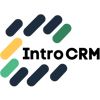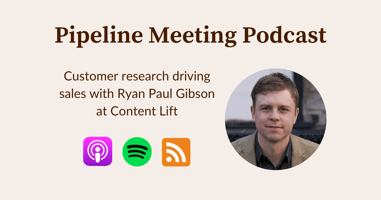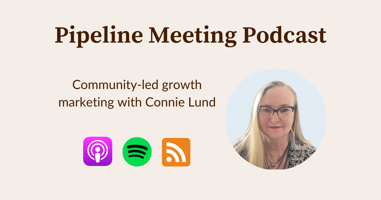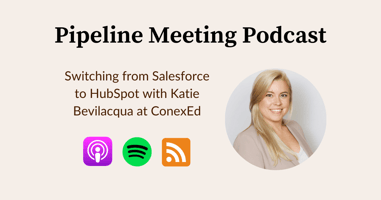Ryan Paul Gibson is the founder of content lift. Ryan explains how customer research can drive...
Demand gen strategy with Janelle Amos at Elevate Growth
This week we talk about demand gen strategy and the overlap between marketing and sales, particularly for B2B SaaS. We're joined by Janelle Amos, the founder of Elevate Growth.
Show Description
Where B2B marketers come to talk sales. 15-minute interviews published every Monday morning. For heads of marketing and founders who support a sales team.
Subscribe
Popular Platforms
Apple Podcasts
Spotify
RSS Feed
Also available:
Amazon | Anghami | Castbox | Castro | Deezer | GoodPods | Google Podcasts | iHeart Radio | Overcast | Pandora | PlayerFM | Pocket Casts | Podcast Index | Podchaser | Stitcher | TuneIn
Show Notes
- Who she helps. There are three typical scenarios when a head of demand gen might be called in to help. She talks about all three, and two tend to work better than the third.
- Why marketing first. Janelle explains why she thinks marketing, and demand gen strategy, should come first when a startup is starting to see traction. She contrasts this to a sales-first approach.
- Why marketing now. She explains how timing is key. There are several specific things she looks for in the market and the product that help her understand if demand gen strategy can help.
- Supporting sales. Janelle shares interesting insight into how the right demand gen strategy can set up the sales team for success. And beyond a nice to have, it may be vital for the success of that sales team. When done right, they can jump in and do their job--selling!
- The ideal tech stack: Always a tricky topic, but Janelle talks about a few different popular tools and how they come together like HubSpot, Salesforce, Marketo, Outreach, and Salesloft.
Elevate Growth: https://elevate-growth.com/
Transcript
Welcome to Pipeline Meeting, where marketers come to talk about sales. Whether you're the head of marketing or a founder who's supporting your first sales hire, we'll talk about qualifying your inbound leads and finding new ones with cold outreach. Learn more at introcrm.com/podcast.
[00:00:20] Harris Kenny: This week we welcome Janelle Amos, who's the founder of Elevate Growth. We talk about demand gen strategy, the overlap between marketing and sales, particularly for B2B SaaS startups that are starting to get some traction.
[00:00:33] Harris Kenny: Let's start with her.
[00:00:34] Janelle Amos: My background is all B2B SaaS startups. Predominantly any startup that's about seed level to about Series C is about where I work best in and I have the bandwidth for to support.
[00:00:45] Janelle Amos: From there it normally is either one to three different scenarios, the first one is that they hired a head of marketing, and they need to have somebody come in to help them actually get the job done.
[00:00:56] Janelle Amos: And either it's they don't have a demand gen background or they have a clear understanding on where they wanna do demand gen with, and they don't have the hands or the bandwidth to actually do it.
[00:01:04] Janelle Amos: I come in and I help make sure to keep that strategy alive.
[00:01:07] Janelle Amos: The second component is you're just working with the founder. They don't know how to get started and they just need marketing entirely and a demand gen motion.
[00:01:14] Janelle Amos: That's when I would work and sell with the founder, and actually get them with their marketing traction going.
[00:01:19] Janelle Amos: The third scenario, which is not as popular as the first two that I mentioned, but it's working with a head of sales.
[00:01:26] Janelle Amos: And the reason for that is a startup hired and built out their sales team first. Now that they're starting to realize that marketing is a critical component of that, the head of sales is that normally that person that steps in to lead the marketing team as well.
[00:01:39] Janelle Amos: While that's not the ideal scenario, cause I believe that marketing should be first prior to sales, that is a scenario that I see often with startups now, as we still need to modernize and revolutionize the way that startups prioritize or go to market motion.
[00:01:51] Harris Kenny: Tell me more about that marketer being what would come first.
[00:01:56] Harris Kenny: For clients who maybe are earlier stage, but they wanna be like your clients who are more successful, the ones who have that marketer come in and set that good foundation.
[00:02:06] Harris Kenny: What does it look like when a company is really ready for you to do your thing?
[00:02:12] Janelle Amos: Yeah, that's so broad 'cause define ready for demand gen, right? I mean, it could just have the idea of wanting to take it somewhere. It could actually have a budget of wanting to take it somewhere. It could have different stages of the product development.
[00:02:26] Janelle Amos: But I think what first comes into priority needs to be do you actually have a product that is marketable? Let's start there first. Do you actually have anything tangible?
[00:02:35] Janelle Amos: And then let's look at the market. Like do you actually have a market for your product? Is the fit there? Is the audience there?
[00:02:42] Janelle Amos: Once those stages are accomplished, I think marketing is the next best option because then we could start understanding how we can take that product to market.
[00:02:51] Janelle Amos: Whereas traditionally, if we start with a sales motion, that starts from an outbound perspective and having work outbounds and cold calling and then cold emails.
[00:03:00] Janelle Amos: The reason why I support marketing first is because marketing can do that at scale. It's a little bit larger of, um, ICP attack versus an individual kind of spraying and praying from an an email perspective with sales.
[00:03:13] Janelle Amos: And a lot of the pushback that I get from here is that marketing is either seen as a cost center or they're not directly, you know, they can't drive the leads and the immediate revenue for the business.
[00:03:23] Janelle Amos: Whereas if sales does outbound, they can.
[00:03:26] Janelle Amos: And my, I guess counter to that is either way you still have a sales cycle.
[00:03:31] Janelle Amos: Even if you hire a salesperson first and they take their time to do the outbound motion, you still have the momentum that they need to gear up to ramp up to outbound to get the calls, to actually get the demos, to get that in a closed won sales cycle.
[00:03:45] Harris Kenny: You mentioned you do B2B SaaS. I'd imagine that that also means longer sales cycle. So from a, from a marketing demand gen perspective, you're also talking about building pipeline too, right?
[00:03:55] Harris Kenny: Like three to six months out versus I feel like conventionally a lot of salespeople are like, "Do you wanna meet tomorrow? Oh no. All right. Nevermind. And I'll never talk to the prospect again."
[00:04:04] Harris Kenny: But it sounds like the potential of building not only short term, but also medium term pipeline is compelling about why those clients are really good fit for you. Do you agree with that?
[00:04:14] Janelle Amos: Yeah, 1000%. I think sales cycles could, it could vary as well, right?
[00:04:17] Janelle Amos: You could have some SaaS that are 90 days. You could have some SaaS. That's two years, depending on how big the buying committee is, what that market fit is, the adjustment that's behind it. If it's an entirely new category, if you're entering something that already has the market buy-in.
[00:04:31] Janelle Amos: So that's why it kind of varies a little bit more, but 1000%, that's why I support them. Marketing is able to do it at a faster ramp up than sales would be.
[00:04:39] Harris Kenny: One challenging thing for sales too is getting that right messaging. If you're coming in totally cold and you're trying to disrupt someone, you know, do that pattern interrupt, you really do have to know that ICP.
[00:04:48] Harris Kenny: It just may be the fact that that messaging, that positioning hasn't been ironed out yet. And so even if you're doing all the right sales practices, you can't get through.
[00:04:58] Harris Kenny: But you can use marketing to maybe iterate 'cause you know these platforms are built for, Google and LinkedIn, are built for that type of iterative testing, right?
[00:05:07] Janelle Amos: And I think the same goes for marketing too.
[00:05:09] Janelle Amos: I mean, I think marketing starts with one set of messaging and figures out if it worked or doesn't work, and they pivot from there too.
[00:05:14] Janelle Amos: I think the messaging game will always be a messaging game, as the market continues to evolve five, 10 years from now.
[00:05:20] Janelle Amos: But what is the beauty of marketing when we're able to actually talk about, from a messaging perspective, and you hit the nail in the head with this one, is, when we start with marketing first, and then marketing is able to get that market buy-in after testing all that messaging.
[00:05:33] Janelle Amos: When somebody comes inbound, they're ready to have those conversations.
[00:05:36] Janelle Amos: The salesperson doesn't have to worry about either convincing or testing messaging or seeing if it resonates. All they have to do is sell. Like do what they're hired to do is sell, right? So that's why it helps.
[00:05:45] Janelle Amos: And I've had a lot of conversations with a lot of, like VP of Sales that I've worked with while I was in-house, where we've talked about why hiring demand gen is the success of a sales team's productivity.
[00:05:56] Janelle Amos: Sales will not survive without demand gen in an early stage startup.
[00:05:59] Janelle Amos: I actually have a podcast about that as well, where I interviewed a BDR manager as well, and I was like, "Listen, tell me why. Talk to me why."
[00:06:05] Janelle Amos: We're just outlining a lot of key components that we're starting to see as we talk about this modernizing marketing and go to market motion, on how we can actually start seeing the success of doing these things in a different order.
[00:06:17] Harris Kenny: Tell me about Go to Market Motions.
[00:06:20] Harris Kenny: The episode that caught my eye was about market disruptive startups, and you're talking about early stage startups and how demand gen is what can feed that sales team.
[00:06:29] Harris Kenny: How is going to market as a market disruptive startup, if you're creating a category or maybe reimagining an existing category?
[00:06:37] Harris Kenny: How's that different than traditional corporate marketing efforts?
[00:06:41] Janelle Amos: Yeah, the easiest way that I can explain that is because nobody has heard of you, knows what you do, you've gotta be absolutely everywhere. With everything, every one and anything possible.
[00:06:52] Janelle Amos: You've gotta find a way to either pay for sponsorships, host sponsorships, do sponsorships, and really have a lot of, no matter where your ICP is putting their attention on, you're there.
[00:07:04] Janelle Amos: That can be really challenging from a budget perspective of trying to understand how we can be in all these places at once.
[00:07:09] Janelle Amos: The way that I, again counter that, is to better recommend how that audience spends their time. And then from there, prioritizing those channels and doing one mass content hub and using that to then chop up and mass distribute if possible.
[00:07:25] Harris Kenny: Okay, give me an example of that.
[00:07:27] Janelle Amos: Yeah, so I think my recommendation for B2B SaaS clients would be either for like a podcast or some sort of live event or roadshow event, or micro event, or like a fireside chat event.
[00:07:40] Janelle Amos: Something that's a little bit of a longer form content that you could use either for internal subject matter experts or to bring on guests, I think that would be the key.
[00:07:49] Janelle Amos: A lot of companies think that a blog is their long form content, and I think it needs to dive a little bit deeper and more strategic than a blog.
[00:07:58] Janelle Amos: What I do for my business is I have my podcast that I use as my long form piece of content, and then I use that to chop up individual portions and I distribute that on LinkedIn. And then I also distribute that on TikTok.
[00:08:10] Janelle Amos: If we translate that to how B2B SaaS models could use for the marketing, they could do a podcast or they can do fireside chats.
[00:08:16] Janelle Amos: They could use that from a long form content interview a subject matter expert, and then drop that on the respective medium, like the podcast medium, and then use that and chop it up.
[00:08:25] Janelle Amos: Now, sales can use it in their outreach. Marketing can use it in LinkedIn ads. Marketing can use it in video ads. Marketing can use it in their own email nurturing.
[00:08:33] Janelle Amos: They can use it TikTok. They can use it for Instagram. They can use it for Instagram Reels. They can use it for YouTube shorts and all of a sudden, like one piece of content can now just be mass distributed.
[00:08:45] Janelle Amos: If you have a video editor, like that's really all that it takes, and just finding a way to use that for the native platforms.
[00:08:50] Janelle Amos: But you've done all the work already. You have the content. You just have to figure out how to slice and dice that, to put that at scale for your audience to start understanding who you are and what you do.
[00:09:01] Harris Kenny: What does your text stack look like when it comes to enabling sales teams? Is there a specific software you'd like to use?
[00:09:08] Harris Kenny: On CRM side or in terms of social publishing, to get visibility into those metrics and to track the customer or like buyer journey.
[00:09:20] Janelle Amos: That's a really loaded question. I think in general, any company should have a marketing automation platform and some sort of sales CRM.
[00:09:28] Janelle Amos: Sometimes that's both. If they buy like a HubSpot sales and marketing platform.
[00:09:32] Janelle Amos: Sometimes that's different, if they do a Marketo and Salesforce.
[00:09:35] Janelle Amos: Say at a minimum we need to be starting there from a tech stack perspective.
[00:09:39] Janelle Amos: And then traditionally, an enablement standpoint, sales also likes to have like a Salesloft or an Outreach type of cadence, sequencing tech stack.
[00:09:49] Janelle Amos: From there in terms of enabling them to leverage this piece of content, I have never met one salesperson that didn't want content from marketing.
[00:09:57] Janelle Amos: They've always had their opinions on what content is needed to help them close deals or why they need content.
[00:10:04] Janelle Amos: And so having the communication that, content is now available and how to use it, has been the success of getting that buy-in. I think more than just needing a specific tech stack.
[00:10:15] Janelle Amos: One of the things that I've actually done in house, which I'm not fully sure I'd recommend today, I don't think it's, it's bad.
[00:10:21] Janelle Amos: I think it could be a very viable strategy. We bought an employee advocacy tool and we used that to add both marketing and sales and corporate, everybody in it to where marketing would publish like a blog, right? Or publish some sort of piece of content.
[00:10:34] Janelle Amos: And then everybody, all they had to do with a click of a button and then they would mass distribute that on their own personal profiles, social profiles like LinkedIn or Twitter.
[00:10:43] Janelle Amos: That's great to get the content at scale. And you, you are tapping other people's individual networks, which I think is valuable if those peers are your ICP.
[00:10:53] Janelle Amos: But I think the, the downside to this component is now understanding that we're not necessarily enabling the voice of the individual people.
[00:11:02] Janelle Amos: In today's day and age for the modern buyer, it's that level of authenticity and relevancy that's gonna be key to kind of cutting the market with that attention.
[00:11:11] Janelle Amos: And if we just go like a spray and pray motion, I don't think that's good enough anymore.
[00:11:15] Janelle Amos: What I would recommend is putting together those pieces of content with ways to use it.
[00:11:20] Janelle Amos: The channels that they could use. Sampled messaging around that and just tell them, if you want to use this copy and paste, go for it.
[00:11:27] Janelle Amos: But it's definitely important for you to also understand what your point of view is on it and to put your own spin on it.
[00:11:33] Janelle Amos: But this is just a piece of content to help you to get the word out, and I would leave it at that.
[00:11:38] Harris Kenny: And how would you say to distribute that? Would you say Slack? Email? Doesn't matter, I guess whatever companies are using for their internal comms?
[00:11:45] Janelle Amos: Yeah, I think that goes back into the internal communications. I've hosted it in Slack. I've hosted it in like their own intranet.
[00:11:52] Janelle Amos: I don't find email to be that most effective. I did an email and Slack and that still didn't work. People don't care about email when it's internally.
[00:11:59] Janelle Amos: Slack, I don't know.
[00:12:00] Janelle Amos: Slack gets hard because you have so many individual conversations. You have group collaborations, and then you have specific channels.
[00:12:08] Janelle Amos: For example, marketing would come in and be like,
[00:12:09] Janelle Amos: "Hey, new piece of content deployed."
[00:12:11] Janelle Amos: "Hey, new piece of content deployed."
[00:12:12] Janelle Amos: And all you see is marketing,
[00:12:13] Janelle Amos: "Hey, new piece of content deployed."
[00:12:15] Janelle Amos: And you never really have any like engagement or any type of use cases from that.
[00:12:20] Janelle Amos: So what I recommend is to have either your marketing leader or your sales leader, or whoever's the enabler between the two teams to sit either on weekly, biweekly, no longer than monthly. And to really talk about the stuff that is coming into pipe.
[00:12:33] Janelle Amos: A lot of people call 'em marketing meetings where you bring marketing and sales together.
[00:12:37] Janelle Amos: You start talking about what's in the pipeline, how they can use it, ways to use it, and just pretty much pull their attention. But I found in general sales needs, or anybody really in today's attention span, needs like five to nine different like reminders of saying,
[00:12:51] Janelle Amos: "Hey, this is available."
[00:12:52] Janelle Amos: "Hey, this is available."
[00:12:53] Janelle Amos: "Hey, did you use this?"
[00:12:55] Janelle Amos: It comes with kind of finagling your way through the leader and getting that buy-in and having your leader help then lead that team into the enablement standpoint instead of the marketing person trying to do that all as well.
[00:13:06] Harris Kenny: So you've got that internal marketing challenge first before you can even get outside of the walls of the company.
[00:13:11] Janelle Amos: Yeah.
[00:13:12] Harris Kenny: Do you do training or coaching or context for your clients when we're talking about social selling, maybe it's unfamiliar to them.
[00:13:22] Harris Kenny: Do you provide any of that or talk to 'em about that or have any resources or ways that you sort of equip them to begin to use their own voice?
[00:13:29] Harris Kenny: Because that is, I think, very contemporary. I think the old way of companies was, "This is the corporate message and you just sort of repeat it. Don't, don't add your own thing." And this is turning it on its head, but is there any work that you need to do to facilitate that.
[00:13:44] Janelle Amos: There's a lot of work that needs to be done. It's not currently something that I offer as my services. I'm more of the demand gen marketer strategy perspective, and then I let anybody else who has that passion to work with the team for that enablement standpoint.
[00:13:56] Harris Kenny: You do have to think about that component, right, of how people will literally execute on it, because they might mess it up, right?
[00:14:03] Janelle Amos: I don't really know if it's messing up their own point of view. I think part of it is making sure that it's even leveraged, right?
[00:14:08] Janelle Amos: I think that goes into the internal communications and the buy-ins and the distribution from that, more so than it is. Getting them to, to write something. I think that's the intimidation part from the individual of like, why my voice?
[00:14:21] Janelle Amos: Why do I need to write something? I'm intimidated.
[00:14:23] Janelle Amos: But again, I, I'm not fully sure that that would align with why we need to be doing this channel strategy to enabling an individual to feel empowered and confident to post on their own personal social profiles. So that's a harder conversation
[00:14:36] Harris Kenny: Totally. Would that translate to partners too? If I'm a company that has partner sales, that needs to carry the message up to me, it feels like a very parallel distribution or go to market question.
[00:14:49] Janelle Amos: Yeah, totally. I think partnerships is also a channel of revenue that is oftentimes overlooked.
[00:14:54] Janelle Amos: A lot of people just think it's marketing or sales or even customer success, but they forget that partnerships is 100% a part of that as well.
[00:15:00] Janelle Amos: And sometimes one of the mass drivers, if we're talking about a startup phase. So really finding ways to enable and tap your partners.
[00:15:06] Harris Kenny: Where can people find Janelle online if they wanna hear more about what you think?
[00:15:10] Janelle Amos: See you on LinkedIn, my handle is gonna be at Janelle Amos. I'm also on TikTok at Janelle Amos as well.
That's all for now. You can find show notes at introcrm.com/podcast. The theme music for Pipeline Meeting is by Neighbourhood Vandal and it's shared under a Creative Commons-Attribution, or CC-BY, license. If you learned something, consider sharing this show with a friend. Thanks.



